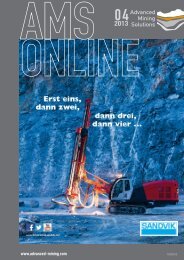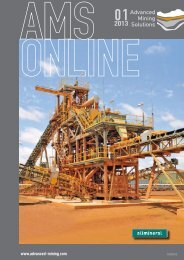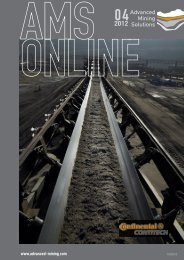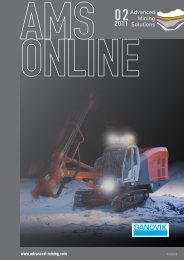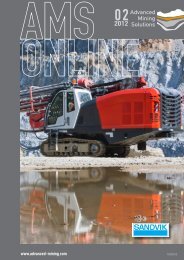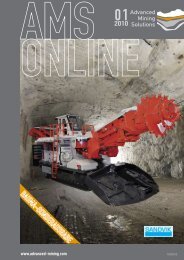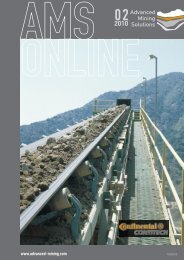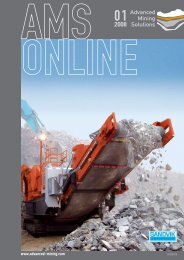A new face drilling rig for narrow tunnels and ... - Advanced Mining
A new face drilling rig for narrow tunnels and ... - Advanced Mining
A new face drilling rig for narrow tunnels and ... - Advanced Mining
You also want an ePaper? Increase the reach of your titles
YUMPU automatically turns print PDFs into web optimized ePapers that Google loves.
Hereby ζ is the coefficient of velocity, as mentioned<br />
above, that lies in the interval of 0 ≤ ζ ≤ 1. The set limits of<br />
the parameter can vividly be described: On one h<strong>and</strong> there<br />
is no conveyance <strong>for</strong> ζ = 0. As demonstrated in picture 2,<br />
this case can also occur in screw driving speeds higher<br />
than n = 0 1/s, if it falls below the minimum driving speed<br />
needed <strong>for</strong> conveyance. On the other h<strong>and</strong> the maximum<br />
axial velocity of material of the horizontal conveyance<br />
is achieved <strong>for</strong> ζ = 1. With the last two equations the<br />
achievable volume flow in inclined screw conveyors can<br />
be summarized as<br />
I V ax<br />
Issue 04 | 2010<br />
2 2 ( D − d ) ⋅π<br />
⋅ S ⋅ ζ<br />
1<br />
= A⋅<br />
v = ϕ ⋅ ⋅<br />
n ⋅<br />
4<br />
Hereby the coefficient of velocity ζ is the last unknown<br />
value <strong>and</strong> is determined as the result of empirical tests,<br />
depending on the described influencing factors.<br />
Calculation of Driving Power<br />
In an inclined screw conveyor the required driving<br />
power also results from a range of different loss portions.<br />
Apart from the lifting power to overcome the difference in<br />
height, there are mainly friction powers between the bulk<br />
material <strong>and</strong> the geometry, as well as power losses inside<br />
the bulk material. From these only the lifting power P Hub can<br />
easily be determined analytically. This is calculated from<br />
the volume flow to be conveyed I V , the bulk density ρ <strong>and</strong><br />
the conveying height H according to <strong>for</strong>mula:<br />
PHub V<br />
= I ⋅ ρ ⋅ g ⋅ H<br />
(7)<br />
For further power losses through friction, among others,<br />
the following are to be mentioned [1]:<br />
• Friction power between good <strong>and</strong> inner wall of the tube<br />
(6)<br />
• Friction power between good <strong>and</strong> screw spiral<br />
• Friction power between good <strong>and</strong> screw shaft<br />
• Power loss in the intermediate bearings<br />
• Gap losses<br />
• Dissipated power in shear planes<br />
• Power losses from acceleration of goods<br />
These loss portions cannot be calculated easily, although<br />
some analytical approaches exist to describe them [1], [6],<br />
[7], [8]. These approaches apply a fictitious total friction<br />
power – based on the semi-empirical approach of Fottner<br />
[9] – which describes all friction parts with the help of<br />
empirically determined parameters. Also in the approach<br />
TRANSFER OF TECHNOLOGY<br />
<strong>for</strong> the friction power the principal approach of DIN 15262<br />
[5], which was also applied by Gabler [7] <strong>and</strong> Vollmann [1]<br />
is used. Here the friction power is calculated similar to<br />
the principle of the Coloumb friction, as the product of a<br />
fictitious conveying factor with the normal <strong>for</strong>ce F N on the<br />
conveying tube <strong>and</strong> the absolute velocity of material v G .<br />
According to Rong [6] the normal <strong>for</strong>ce on the conveying<br />
tube is proportional to the conveyed volume flow I V . The<br />
acceleration a of the mass is dependant on the type<br />
of conveyance - translational <strong>and</strong> rotational portions-<br />
<strong>and</strong> is initially disregarded. With the bulk density ρ, the<br />
conveyance length L <strong>and</strong> the axial velocity of the good v ax<br />
the normal <strong>for</strong>ce F N results as:<br />
F<br />
IV<br />
⋅ ρ<br />
= ⋅ L ⋅ a (8)<br />
v<br />
N<br />
a x<br />
According to Vollmann [1], the absolute velocity of goods<br />
can be presented with inclusion of the velocity parameter<br />
ζ with the screw diameter D, the rotation speed n <strong>and</strong> the<br />
screw pitch S:<br />
v G<br />
= D ⋅π<br />
⋅ n ⋅<br />
⎡<br />
−1<br />
( 1−<br />
ζ ) ⋅ cos ⎢arctan⎜<br />
⋅ ⎟⎥<br />
⎝1<br />
− ζ D ⋅π<br />
⎠⎦<br />
⎣<br />
⎛<br />
ζ<br />
S<br />
⎞⎤<br />
(9)<br />
In order to have a simple <strong>and</strong> practical dimensioning<br />
method <strong>for</strong> the determination of the power losses through<br />
friction, the portions depending on the coefficient of<br />
velocity ζ as well as the unknown fictitious conveyance<br />
factor are combined to the coefficient of power λ. The<br />
acceleration a of the mass in the screw conveyor is also<br />
included as portion of the gravitational acceleration g.<br />
This is required, as the type of conveyance is not known.<br />
However this is of decisive importance <strong>for</strong> the type of<br />
acceleration that influences the bulk material. In case of a<br />
purely translational conveyance, the bulk material is only<br />
subjected to gravitational acceleration. In case a rotational<br />
portion is included, the bulk material is also influenced by<br />
centripetal acceleration, <strong>and</strong> in case of a vertical screw<br />
conveyor, this type of acceleration is exclusively present.<br />
There<strong>for</strong>e the following correlation results <strong>for</strong> the fictitious<br />
total friction power:<br />
D<br />
= λ ⋅ ⋅ I ⋅ ρ ⋅ g ⋅ L<br />
S<br />
(10)<br />
PReib V<br />
As such the components of the required power <strong>for</strong><br />
conveyance in an inclined screw conveyor are known <strong>and</strong><br />
can be summarized as follows:<br />
⎛ D ⎞<br />
= PReib<br />
+ PHub<br />
= I ⋅ ρ ⋅ g ⋅⎜<br />
λ ⋅ ⋅ L + H ⎟ (11)<br />
⎝ S ⎠<br />
P V<br />
www.advanced-mining.com<br />
47



